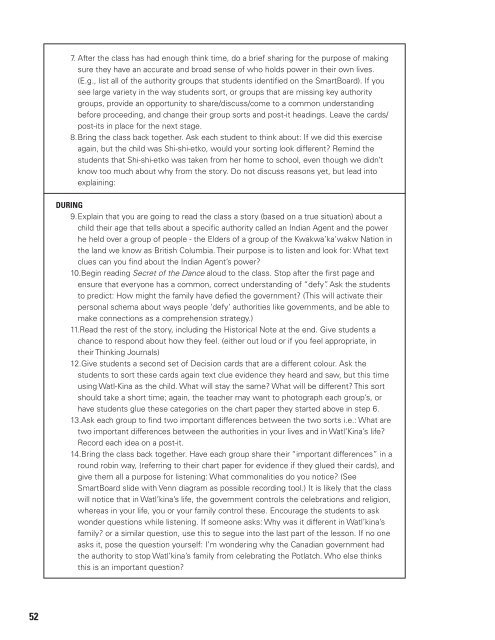Residential Residential
Residential_School
Residential_School
You also want an ePaper? Increase the reach of your titles
YUMPU automatically turns print PDFs into web optimized ePapers that Google loves.
7. After the class has had enough think time, do a brief sharing for the purpose of making<br />
sure they have an accurate and broad sense of who holds power in their own lives.<br />
(E.g., list all of the authority groups that students identified on the SmartBoard). If you<br />
see large variety in the way students sort, or groups that are missing key authority<br />
groups, provide an opportunity to share/discuss/come to a common understanding<br />
before proceeding, and change their group sorts and post-it headings. Leave the cards/<br />
post-its in place for the next stage.<br />
8. Bring the class back together. Ask each student to think about: If we did this exercise<br />
again, but the child was Shi-shi-etko, would your sorting look different? Remind the<br />
students that Shi-shi-etko was taken from her home to school, even though we didn’t<br />
know too much about why from the story. Do not discuss reasons yet, but lead into<br />
explaining:<br />
DURING<br />
9. Explain that you are going to read the class a story (based on a true situation) about a<br />
child their age that tells about a specific authority called an Indian Agent and the power<br />
he held over a group of people - the Elders of a group of the Kwakwa’ka’wakw Nation in<br />
the land we know as British Columbia. Their purpose is to listen and look for: What text<br />
clues can you find about the Indian Agent’s power?<br />
10.Begin reading Secret of the Dance aloud to the class. Stop after the first page and<br />
ensure that everyone has a common, correct understanding of “defy”. Ask the students<br />
to predict: How might the family have defied the government? (This will activate their<br />
personal schema about ways people ‘defy’ authorities like governments, and be able to<br />
make connections as a comprehension strategy.)<br />
11.Read the rest of the story, including the Historical Note at the end. Give students a<br />
chance to respond about how they feel. (either out loud or if you feel appropriate, in<br />
their Thinking Journals)<br />
12.Give students a second set of Decision cards that are a different colour. Ask the<br />
students to sort these cards again text clue evidence they heard and saw, but this time<br />
using Watl-Kina as the child. What will stay the same? What will be different? This sort<br />
should take a short time; again, the teacher may want to photograph each group’s, or<br />
have students glue these categories on the chart paper they started above in step 6.<br />
13.Ask each group to find two important differences between the two sorts i.e.: What are<br />
two important differences between the authorities in your lives and in Watl’Kina’s life?<br />
Record each idea on a post-it.<br />
14.Bring the class back together. Have each group share their “important differences” in a<br />
round robin way, (referring to their chart paper for evidence if they glued their cards), and<br />
give them all a purpose for listening: What commonalities do you notice? (See<br />
SmartBoard slide with Venn diagram as possible recording tool.) It is likely that the class<br />
will notice that in Watl’kina’s life, the government controls the celebrations and religion,<br />
whereas in your life, you or your family control these. Encourage the students to ask<br />
wonder questions while listening. If someone asks: Why was it different in Watl’kina’s<br />
family? or a similar question, use this to segue into the last part of the lesson. If no one<br />
asks it, pose the question yourself: I’m wondering why the Canadian government had<br />
the authority to stop Watl’kina’s family from celebrating the Potlatch. Who else thinks<br />
this is an important question?<br />
52


